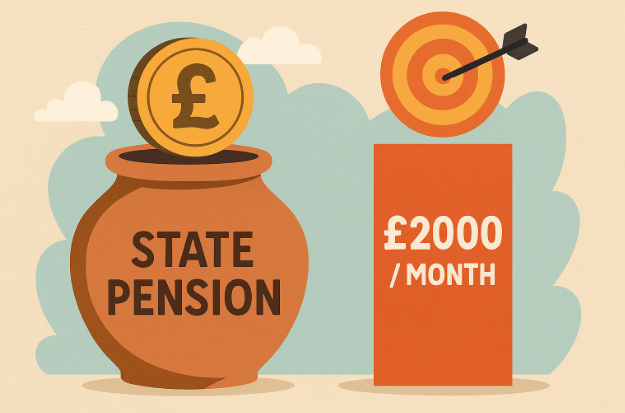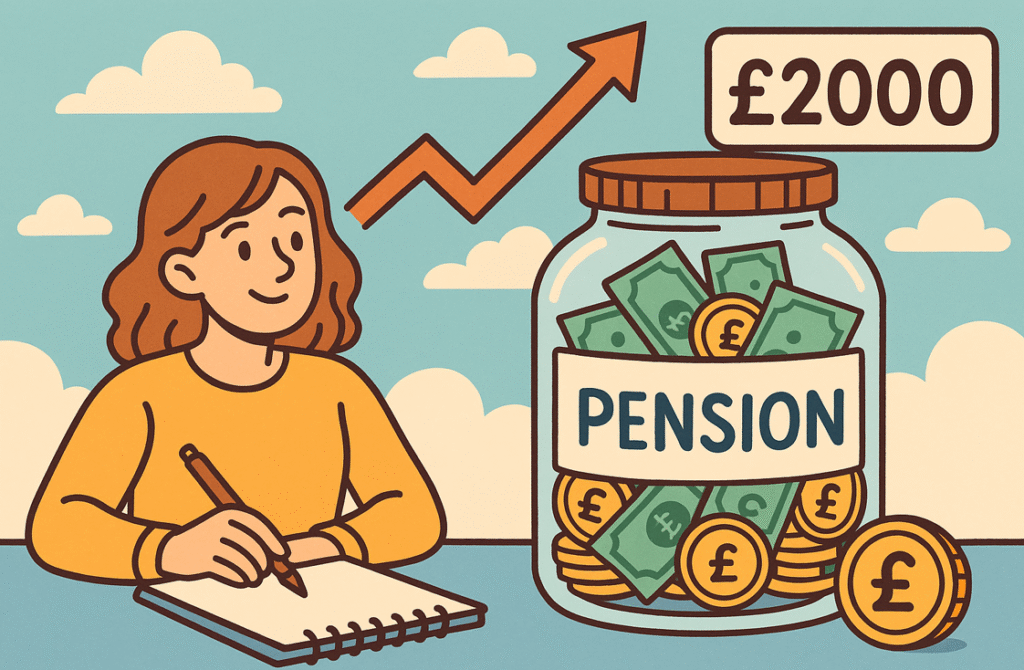How Much Pension Pot Do I Need for £2000 Per Month? Planning for retirement is one of the most important financial steps you can take, especially when aiming for a specific income like £2000 per month. This amount is often considered a comfortable standard for many retirees in the UK, covering not just the basics but also discretionary spending on hobbies, travel, and a good quality of life. But how large does your pension pot need to be to sustain this income throughout retirement?
In this comprehensive guide, we explore exactly how much pension pot you need to achieve £2000 per month in retirement. We’ll break down different scenarios based on State Pension contributions, Defined Contribution and Defined Benefit schemes, tax implications, inflation, and common retirement products such as annuities and pension drawdown.
Whether you’re just starting to save or approaching retirement age, this guide will give you the insights needed to set realistic goals and build the pension pot necessary for a financially secure future.
What does a £2000 monthly income in retirement really mean?
A monthly income of £2,000 in retirement equates to £24,000 annually, offering a lifestyle that’s generally considered more than “moderate” but not ultra-luxurious. According to the PLSA, this level covers:
-
Regular meals out and social activities
-
Annual UK and occasional overseas holidays
-
Generous clothing and personal spending budget
-
Car ownership and home maintenance
-
A financial buffer for unexpected expenses
This level of income supports a balanced and comfortable retirement, especially when mortgage or rent is no longer a major expense.
How much pension pot is needed for £2000 per month using the 4% rule?
The 4% rule assumes you can safely withdraw 4% of your pension each year, keeping your capital mostly intact over 30 years.
Calculation:
-
Annual income: £24,000
-
Required pot: £24,000 ÷ 0.04 = £600,000
Underlying assumptions:
-
Average investment growth: 5–6% annually
-
Inflation: 2%
-
Balanced portfolio (equities and bonds)
-
Retirement span: 30 years or more
Note: The 4% rule is a guide, not a guarantee. Market volatility and inflation may affect long-term outcomes.
How does the State Pension impact your £2000/month goal?

The full new UK State Pension (2025/26) pays approximately £10,600 per year, or around £883/month. If you qualify, this significantly reduces how much you need from private or workplace pensions.
Adjusted target:
-
£24,000 – £10,600 = £13,400 needed annually
-
£13,400 ÷ 0.04 = £335,000 pot required
This approach assumes you start receiving your State Pension at age 66. If you retire earlier, you’ll need to self-fund the gap.
How much do I need if I opt for an annuity instead of drawdown?
An annuity provides fixed or inflation-linked income for life. It’s ideal for those seeking income certainty without managing investments.
Pot needed for level annuity:
-
£24,000 ÷ 0.055 (5.5% rate) = £436,000
Pot needed for inflation-linked annuity:
-
£24,000 ÷ 0.035 (3.5% rate) = £685,000
Factors affecting rates:
-
Age at purchase
-
Gender (unisex rates now used)
-
Health/lifestyle
-
Inflation protection
Annuities are less flexible but eliminate investment risk.
What tax implications come with a £2000/month pension income?
The UK personal allowance is £12,570 (2025/26). Above this, income is subject to 20% tax up to £50,270.
Tax scenario:
-
Total income: £24,000
-
Tax-free: £12,570
-
Taxed: £11,430 × 20% = £2,286
-
Net income: £21,714/year or ~£1,809/month
To achieve £2,000/month net, you’d need:
-
Gross income: £26,000
-
Tax on £13,430 = £2,686
-
Net = £23,314/year
-
Pot required: £26,000 ÷ 0.04 = £650,000
How does inflation affect the long-term sustainability of your income?
Inflation steadily erodes purchasing power. With 2% annual inflation:
-
£2,000 today = £1,640 in 10 years
-
£2,000 today = £1,350 in 20 years
Ways to protect against inflation:
-
Use inflation-linked drawdown (withdraw higher amounts over time)
-
Choose inflation-protected annuities
-
Invest in real assets (e.g., equities, property)
-
Increase your pension pot by 20–30%
What’s the difference between Defined Benefit and Defined Contribution pensions?
| Feature | Defined Benefit (DB) | Defined Contribution (DC) |
|---|---|---|
| Income | Fixed, based on salary & service | Variable, based on contributions & investments |
| Risk | Employer bears risk | You bear the risk |
| Flexibility | Limited | High (e.g., drawdown, lump sums) |
| Examples | NHS, Civil Service | Private pensions, SIPPs |
If you have a DB scheme, it may already provide part or all of your £2,000 target. DC pensions require you to manage income drawdown carefully.
How long will a pension pot last when drawing £2000/month?
Drawdown longevity estimates:
-
£600,000 at 4%: ~30 years
-
£700,000 at 3.5%: ~35+ years
-
£800,000 at 3%: may last indefinitely (with market support)
Conservative withdrawal rates improve sustainability. Adjusting spending during market dips helps extend pot life.
How to build a pension pot of £600,000?
Monthly contribution estimates (assuming 5% return):
-
Start at 30: £450/month
-
Start at 40: £630/month
-
Start at 50: £930/month
Strategies:
-
Maximise employer contributions
-
Claim tax relief (up to 45% depending on income)
-
Use pensions before ISAs for long-term growth
-
Increase contributions after pay rises or mortgage payoff
Can I live off the State Pension alone?

Unlikely. The full State Pension provides ~£10,600/year. That’s less than half the £24,000 needed for £2,000/month. Without a private pension, you’d need to significantly reduce your lifestyle or rely on Pension Credit or housing support.
How does retiring early impact the pot I need?
Retiring at 60, before the State Pension age of 66, means bridging a 6-year income gap.
Example:
-
£24,000 × 6 = £144,000
-
Add to £600,000 = £744,000 total pot needed
-
Alternatively, delay retirement or reduce spending in early years
How much should I be contributing now to reach this goal?
General rule of thumb: Save a % of salary equal to half your age.
-
Age 30: 12%
-
Age 40: 18%
-
Age 50: 25%
Include employer contributions in these totals. Review your pension annually and adjust for inflation and salary increases.
What does Martin Lewis recommend for pension planning?
Martin Lewis’ key recommendations include:
-
Start early: compound growth benefits younger savers
-
Make the most of your employer’s pension match; it’s free.
-
Check your State Pension forecast on gov.uk
-
Fill NI gaps using voluntary contributions if needed
-
Model your objectives with the pension calculators and MoneyHelper.
- Avoid early withdrawals unless absolutely necessary
How much pension pot do I need for £2000 per month after tax?
To receive £2,000/month net, accounting for tax:
-
Gross required: ~£26,000
-
Pot needed using 4% rule: £650,000
If the State Pension (Read – How to avoid paying tax on your pension) covers £10,600 of this, the revised pot needed is ~£390,000, assuming you delay withdrawals until age 66.
Conclusion: How much pension pot do you need for £2000 per month?
To secure a retirement income of £2000/month, the average UK saver needs between £600,000 and £685,000, depending on method, inflation protection, and State Pension eligibility. Using the State Pension can reduce this burden by over £260,000. Make sure to consider inflation, tax, and longevity when planning.
FAQs
Q: Can I rely solely on the State Pension for £2000/month?
A: No. The State Pension provides less than £900/month. You must supplement it with a private or workplace pension.
Q: Is a 4% drawdown rule still valid in 2025?
A: It’s a guideline. You may need to adjust based on inflation and market performance.
Q: Is an annuity better than drawdown?
A: An annuity offers stability, but drawdown gives flexibility. Your health and risk tolerance will determine this.
Q: How does retiring earlier affect the pot I need?
A: The earlier you retire, the larger your pot must be. You need to fund more years without State Pension initially.
Q: Are pension pots taxed in the UK?
A: Yes. 25% is tax-free, but the rest is taxed as income above your personal allowance.
I’m Laura Wilson, a passionate blogger and content creator with a deep interest in business, finance, and entrepreneurship. I’ve had the opportunity to write for several premium blogs, sharing insights & practical advice for individuals & small businesses. I’m the founder and publisher of ukbusinessmag.co.uk, where I focus on creating valuable, easy-to-understand content to help UK startups & SMEs grow.



